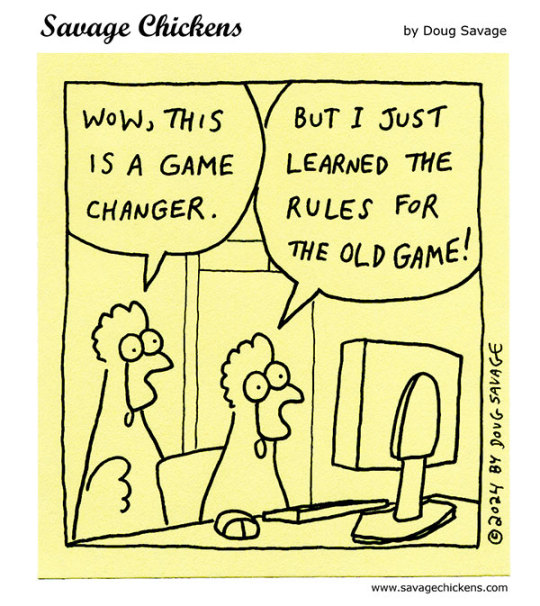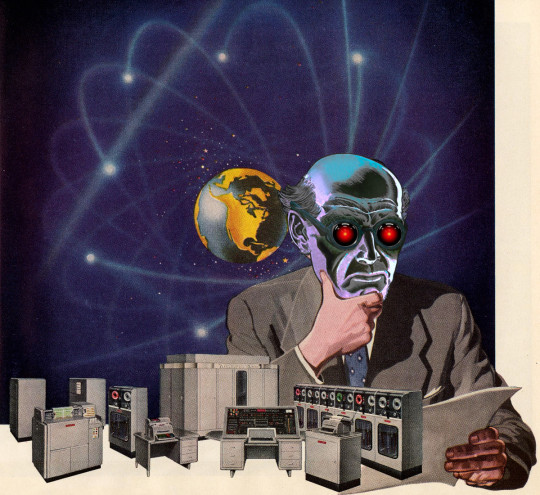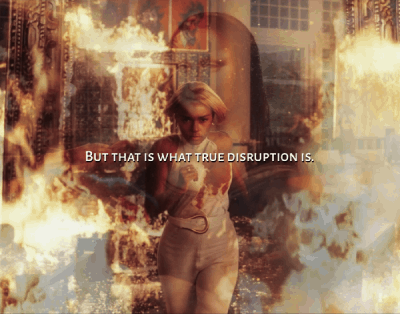#disruption
Text

Game Changer.
And other changes.
30 notes
·
View notes
Text

Star Fox
1K notes
·
View notes
Text
Big Tech disrupted disruption

If you'd like an essay-formatted version of this post to read or share, here's a link to it on pluralistic.net, my surveillance-free, ad-free, tracker-free blog:
https://pluralistic.net/2024/02/08/permanent-overlords/#republicans-want-to-defund-the-police

Before "disruption" turned into a punchline, it was a genuinely exciting idea. Using technology, we could connect people to one another and allow them to collaborate, share, and cooperate to make great things happen.
It's easy (and valid) to dismiss the "disruption" of Uber, which "disrupted" taxis and transit by losing $31b worth of Saudi royal money in a bid to collapse the world's rival transportation system, while quietly promising its investors that it would someday have pricing power as a monopoly, and would attain profit through price-gouging and wage-theft.
Uber's disruption story was wreathed in bullshit: lies about the "independence" of its drivers, about the imminence of self-driving taxis, about the impact that replacing buses and subways with millions of circling, empty cars would have on traffic congestion. There were and are plenty of problems with traditional taxis and transit, but Uber magnified these problems, under cover of "disrupting" them away.
But there are other feats of high-tech disruption that were and are genuinely transformative – Wikipedia, GNU/Linux, RSS, and more. These disruptive technologies altered the balance of power between powerful institutions and the businesses, communities and individuals they dominated, in ways that have proven both beneficial and durable.
When we speak of commercial disruption today, we usually mean a tech company disrupting a non-tech company. Tinder disrupts singles bars. Netflix disrupts Blockbuster. Airbnb disrupts Marriott.
But the history of "disruption" features far more examples of tech companies disrupting other tech companies: DEC disrupts IBM. Netscape disrupts Microsoft. Google disrupts Yahoo. Nokia disrupts Kodak, sure – but then Apple disrupts Nokia. It's only natural that the businesses most vulnerable to digital disruption are other digital businesses.
And yet…disruption is nowhere to be seen when it comes to the tech sector itself. Five giant companies have been running the show for more than a decade. A couple of these companies (Apple, Microsoft) are Gen-Xers, having been born in the 70s, then there's a couple of Millennials (Amazon, Google), and that one Gen-Z kid (Facebook). Big Tech shows no sign of being disrupted, despite the continuous enshittification of their core products and services. How can this be? Has Big Tech disrupted disruption itself?
That's the contention of "Coopting Disruption," a new paper from two law profs: Mark Lemley (Stanford) and Matthew Wansley (Yeshiva U):
https://papers.ssrn.com/sol3/papers.cfm?abstract_id=4713845
The paper opens with a review of the literature on disruption. Big companies have some major advantages: they've got people and infrastructure they can leverage to bring new products to market more cheaply than startups. They've got existing relationships with suppliers, distributors and customers. People trust them.
Diversified, monopolistic companies are also able to capture "involuntary spillovers": when Google spends money on AI for image recognition, it can improve Google Photos, YouTube, Android, Search, Maps and many other products. A startup with just one product can't capitalize on these spillovers in the same way, so it doesn't have the same incentives to spend big on R&D.
Finally, big companies have access to cheap money. They get better credit terms from lenders, they can float bonds, they can tap the public markets, or just spend their own profits on R&D. They can also afford to take a long view, because they're not tied to VCs whose funds turn over every 5-10 years. Big companies get cheap money, play a long game, pay less to innovate and get more out of innovation.
But those advantages are swamped by the disadvantages of incumbency, all the various curses of bigness. Take Arrow's "replacement effect": new companies that compete with incumbents drive down the incumbents' prices and tempt their customers away. But an incumbent that buys a disruptive new company can just shut it down, and whittle down its ideas to "sustaining innovation" (small improvements to existing products), killing "disruptive innovation" (major changes that make the existing products obsolete).
Arrow's Replacement Effect also comes into play before a new product even exists. An incumbent that allows a rival to do R&D that would eventually disrupt its product is at risk; but if the incumbent buys this pre-product, R&D-heavy startup, it can turn the research to sustaining innovation and defund any disruptive innovation.
Arrow asks us to look at the innovation question from the point of view of the company as a whole. Clayton Christensen's "Innovator's Dilemma" looks at the motivations of individual decision-makers in large, successful companies. These individuals don't want to disrupt their own business, because that will render some part of their own company obsolete (perhaps their own division!). They also don't want to radically change their customers' businesses, because those customers would also face negative effects from disruption.
A startup, by contrast, has no existing successful divisions and no giant customers to safeguard. They have nothing to lose and everything to gain from disruption. Where a large company has no way for individual employees to initiate major changes in corporate strategy, a startup has fewer hops between employees and management. What's more, a startup that rewards an employee's good idea with a stock-grant ties that employee's future finances to the outcome of that idea – while a giant corporation's stock bonuses are only incidentally tied to the ideas of any individual worker.
Big companies are where good ideas go to die. If a big company passes on its employees' cool, disruptive ideas, that's the end of the story for that idea. But even if 100 VCs pass on a startup's cool idea and only one VC funds it, the startup still gets to pursue that idea. In startup land, a good idea gets lots of chances – in a big company, it only gets one.
Given how innately disruptable tech companies are, given how hard it is for big companies to innovate, and given how little innovation we've gotten from Big Tech, how is it that the tech giants haven't been disrupted?
The authors propose a four-step program for the would-be Tech Baron hoping to defend their turf from disruption.
First, gather information about startups that might develop disruptive technologies and steer them away from competing with you, by investing in them or partnering with them.
Second, cut off any would-be competitor's supply of resources they need to develop a disruptive product that challenges your own.
Third, convince the government to pass regulations that big, established companies can comply with but that are business-killing challenges for small competitors.
Finally, buy up any company that resists your steering, succeeds despite your resource war, and escapes the compliance moats of regulation that favors incumbents.
Then: kill those companies.
The authors proceed to show that all four tactics are in play today. Big Tech companies operate their own VC funds, which means they get a look at every promising company in the field, even if they don't want to invest in them. Big Tech companies are also awash in money and their "rival" VCs know it, and so financial VCs and Big Tech collude to fund potential disruptors and then sell them to Big Tech companies as "aqui-hires" that see the disruption neutralized.
On resources, the authors focus on data, and how companies like Facebook have explicit policies of only permitting companies they don't see as potential disruptors to access Facebook data. They reproduce internal Facebook strategy memos that divide potential platform users into "existing competitors, possible future competitors, [or] developers that we have alignment with on business models." These categories allow Facebook to decide which companies are capable of developing disruptive products and which ones aren't. For example, Amazon – which doesn't compete with Facebook – is allowed to access FB data to target shoppers. But Messageme, a startup, was cut off from Facebook as soon as management perceived them as a future rival. Ironically – but unsurprisingly – Facebook spins these policies as pro-privacy, not anti-competitive.
These data policies cast a long shadow. They don't just block existing companies from accessing the data they need to pursue disruptive offerings – they also "send a message" to would-be founders and investors, letting them know that if they try to disrupt a tech giant, they will have their market oxygen cut off before they can draw breath. The only way to build a product that challenges Facebook is as Facebook's partner, under Facebook's direction, with Facebook's veto.
Next, regulation. Starting in 2019, Facebook started publishing full-page newspaper ads calling for regulation. Someone ghost-wrote a Washington Post op-ed under Zuckerberg's byline, arguing the case for more tech regulation. Google, Apple, OpenAI other tech giants have all (selectively) lobbied in favor of many regulations. These rules covered a lot of ground, but they all share a characteristic: complying with them requires huge amounts of money – money that giant tech companies can spare, but potential disruptors lack.
Finally, there's predatory acquisitions. Mark Zuckerberg, working without the benefit of a ghost writer (or in-house counsel to review his statements for actionable intent) has repeatedly confessed to buying companies like Instagram to ensure that they never grow to be competitors. As he told one colleague, "I remember your internal post about how Instagram was our threat and not Google+. You were basically right. The thing about startups though is you can often acquire them.”
All the tech giants are acquisition factories. Every successful Google product, almost without exception, is a product they bought from someone else. By contrast, Google's own internal products typically crash and burn, from G+ to Reader to Google Videos. Apple, meanwhile, buys 90 companies per year – Tim Apple brings home a new company for his shareholders more often than you bring home a bag of groceries for your family. All the Big Tech companies' AI offerings are acquisitions, and Apple has bought more AI companies than any of them.
Big Tech claims to be innovating, but it's really just operationalizing. Any company that threatens to disrupt a tech giant is bought, its products stripped of any really innovative features, and the residue is added to existing products as a "sustaining innovation" – a dot-release feature that has all the innovative disruption of rounding the corners on a new mobile phone.
The authors present three case-studies of tech companies using this four-point strategy to forestall disruption in AI, VR and self-driving cars. I'm not excited about any of these three categories, but it's clear that the tech giants are worried about them, and the authors make a devastating case for these disruptions being disrupted by Big Tech.
What do to about it? If we like (some) disruption, and if Big Tech is enshittifying at speed without facing dethroning-by-disruption, how do we get the dynamism and innovation that gave us the best of tech?
The authors make four suggestions.
First, revive the authorities under existing antitrust law to ban executives from Big Tech companies from serving on the boards of startups. More broadly, kill interlocking boards altogether. Remember, these powers already exist in the lawbooks, so accomplishing this goal means a change in enforcement priorities, not a new act of Congress or rulemaking. What's more, interlocking boards between competing companies are illegal per se, meaning there's no expensive, difficult fact-finding needed to demonstrate that two companies are breaking the law by sharing directors.
Next: create a nondiscrimination policy that requires the largest tech companies that share data with some unaffiliated companies to offer data on the same terms to other companies, except when they are direct competitors. They argue that this rule will keep tech giants from choking off disruptive technologies that make them obsolete (rather than competing with them).
On the subject of regulation and compliance moats, they have less concrete advice. They counsel lawmakers to greet tech giants' demands to be regulated with suspicion, to proceed with caution when they do regulate, and to shape regulation so that it doesn't limit market entry, by keeping in mind the disproportionate burdens regulations put on established giants and small new companies. This is all good advice, but it's more a set of principles than any kind of specific practice, test or procedure.
Finally, they call for increased scrutiny of mergers, including mergers between very large companies and small startups. They argue that existing law (Sec 2 of the Sherman Act and Sec 7 of the Clayton Act) both empower enforcers to block these acquisitions. They admit that the case-law on this is poor, but that just means that enforcers need to start making new case-law.
I like all of these suggestions! We're certainly enjoying a more activist set of regulators, who are more interested in Big Tech, than we've seen in generations.
But they are grossly under-resourced even without giving them additional duties. As Matt Stoller points out, "the DOJ's Antitrust Division has fewer people enforcing anti-monopoly laws in a $24 trillion economy than the Smithsonian Museum has security guards."
https://www.thebignewsletter.com/p/congressional-republicans-to-defund
What's more, Republicans are trying to slash their budgets even further. The American conservative movement has finally located a police force they're eager to defund: the corporate police who defend us all from predatory monopolies.

Image:
Cryteria (modified)
https://commons.wikimedia.org/wiki/File:HAL9000.svg
CC BY 3.0
https://creativecommons.org/licenses/by/3.0/deed.en
#pluralistic#coopting disruption#law and political economy#law#economics#competition#big tech#tech#innovation#acquihires#predatory acquisitions#mergers and acquisitions#disruption#schumpeter#the curse of bigness#clay christensen#josef schumpeter#christensen#enshittiification#business#regulation#scholarship
284 notes
·
View notes
Text


Disruption
(Apologies for the picture quality. My phone camera doesn't pick up the details I want it to. And I live in a dark house so lighting is tricky.)
109 notes
·
View notes
Text
Free Palestine 🇵🇸🍉
RAISE YOUR VOICE & RB!
____________________________
How to Take Action:
Non-monetary:
INCREDIBLE NEWS FOR USAMERICANS!!!!!!!
Click for UNRWA
Palestine Child Identification Form
Find ways to disrupt under step #3 in this toolkit: bit.ly/StopGazaGenocide
Protest: Find a protest near you at uscpr.org/protests.
Adalah Justice Project: adalahjusticeproject.org
Palestine Writes Literature Festival: palestinewrites.org
Contact your elected representatives to demand a #CeasefireNOW.
Call Congress: uscpr.org/StopArmingIsrael
Email Congress: uscpr.org/GazaEmail
Watch the hearing where Biden was charged with Genocide: bit.ly/PalestinevBiden
Plan an action: https://actionnetwork.org/forms/biden-got-sued-national-day-of-action-for-permanent-ceasefire-now/
Support BDS. Boycott, divestment, and sanctions are tactics to support Palestinian rights by raising economic pressure on Israel and complicit entities.
See the BDS list: https://bdsmovement.net/Act-Now-Against-These-Companies-Profiting-From-Genocide
Support the #SpeakUpSMP influencer boycott of St. Martin’s Press: r4a.carrd.co
Support Palestinian authors, illustrators, and publishers.
Monetary assistance:
Palestine Children’s Relief Fund: pcrf.net
Donate to Care For Gaza: https://twitter.com/CareForGaza
Donate eSIMS. While Israel has blocked telecommunications, eSIMS are the only way Palestinians in Gaza can communicate.
Support Books for Palestine. Buy books through the Books for Palestine bookshop, and consider donating to the three organizations Books for Palestine has been fundraising for.
Books for Palestine bookshop: bookshop.org/shop/booksforpalestine
UNRWA

#disruption#kidlit4ceasefire#strike for gaza#strike for palestine#free palestine#palestine#publishing industry#publishing#petition#ceasefire now#global strike
99 notes
·
View notes
Text

A painting from uni I had to do a few weeks ago. Lots of experimentation, very happy with it overall
119 notes
·
View notes
Text

Doris Salcedo, Colombian, b. 1958 Untitled, 2008 Wood and concrete 85 5/8 × 95 1/4 × 40 in. (220 × 242 × 120 cm) Collection Museum of Contemporary Art Chicago
318 notes
·
View notes
Text

DISRUPTION X3
#dave and bambi#dave and bambi golden apple#golden apple fnf#apple core#art#drawdrawdraw#drawing#fnf dnb#fanart#fnf dave and bambi#disruption
35 notes
·
View notes
Text

Name: Disgusted Disruption Bambi
Age: 35
Gender: Male
Color: Green
Emotion: Disgust
Species: Bambiverse/Emotion 3D
Power: Nature
Based and inspired: Bambi/3D, Disgust
Friends:
Scared Bandu (Friend and allied)
Rage Expunged (Friend)
Sad Bambi
Happy Dave
Silly Tristan
Loving Star Lightness
Embarrassed Kai Darkness
Confused Bendy
Enemies:
Mischievous Zardy (Arch-enemy)
Neon Dark Cablecrow
Lavender Emily Darkness
Ruby Zero Ouelette
Dark Happy Dave
Dark Sad Bambi
Dark Silly Tristan
Dark Loving Black Star
Dark Scared Bandu
Dark Rage Expunged
Dark Disgusted Disruption Bambi (Arch-enemy)
Dark Embarrassed Kai Darkness
Dark Confused Ink Demon
#dave and bambi#fnf#golden apple fnf#dave and bambi fnf#dave and bambi golden apple#dnb#disruption#disruption bambi#bambi fnf#dnb bambi#bambi dnb#dnb fanart#dnb fnf#fnf dnb#bambi#dave and bambi mod#my art#oc art#oc#ocs#my ocs#the friendship emotional#tfe#disgusted disruption bambi#tfe disgusted disruption bambi#disgusted disruption bambi tfe#green#disgust#emotions#emotion
15 notes
·
View notes
Text
hi tumblr

oops i dropped my disruption bambi icons on the ground
#baldis basics#dave and bambi#dave and bambi golden apple#dnb#fnf#fnf dnb#modeling#paint 3d#disruption#bambi
24 notes
·
View notes
Text








Glass Onion (2022)
78 notes
·
View notes
Photo

Presque tous les livres sont des corrupteurs, les meilleurs font presque autant de mal que de bien.
- Nicolas Chamfort
#chamfort#nicolas chamfort#quote#french#books#beauty#femme#reading#corruption#all books are corrupting#disruption#wisdom#knowledge#arts#culture
54 notes
·
View notes
Text
Silicon Valley ideology valorises disruption in the board-room but crushes it in the increasingly digitised and surveilled classroom, and grinds its face into the concrete floor of the Amazon warehouse.
-Maria Farrell
49 notes
·
View notes
Text

WIP
74 notes
·
View notes
Text
The Disruptive Potential of Cryptocurrency, Blockchain, and DLT
Cryptocurrency, blockchain, and Distributed Ledger Technology (DLT) have been disrupting industries and challenging traditional business models since their inception. These technologies have the potential to revolutionize the way we do business, interact with each other, and even govern ourselves. In this blog post, we will explore the disruptive potential of cryptocurrency, blockchain, and DLT.
Cryptocurrency
Cryptocurrency, such as Bitcoin and Ethereum, is a decentralized digital currency that uses cryptography to secure transactions and control the creation of new units. Cryptocurrency has the potential to disrupt traditional financial systems by providing a more secure and transparent way to transfer value. Cryptocurrency eliminates the need for intermediaries, such as banks, and can help reduce transaction fees and increase financial inclusion.
Blockchain
Blockchain is a distributed ledger that records transactions in a secure and transparent way. Each block in the chain contains a cryptographic hash of the previous block, creating an immutable record of all transactions on the network. Blockchain has the potential to disrupt a wide range of industries, including finance, healthcare, and supply chain management. Blockchain can help increase transparency, reduce fraud, and improve efficiency.
Distributed Ledger Technology (DLT)
DLT is a type of database that is distributed across a network of computers. Each computer in the network has a copy of the database, and any changes to the database are recorded in a transparent and immutable way. DLT has the potential to disrupt a wide range of industries, including finance, healthcare, and government. DLT can help increase transparency, reduce fraud, and improve efficiency.
Disruptive Potential
The disruptive potential of cryptocurrency, blockchain, and DLT is significant. Here are some of the ways that these technologies could disrupt traditional industries:
Finance
Cryptocurrency and blockchain have the potential to disrupt traditional financial systems by providing a more secure and transparent way to transfer value. Cryptocurrency eliminates the need for intermediaries, such as banks, and can help reduce transaction fees and increase financial inclusion. Blockchain can also help reduce fraud and increase transparency in financial transactions.
Healthcare
Blockchain and DLT have the potential to disrupt the healthcare industry by providing a more secure and transparent way to store and share patient data. Blockchain can help increase patient privacy and reduce the risk of data breaches. DLT can also help improve the efficiency of healthcare systems by reducing administrative costs and improving supply chain management.
Government
DLT has the potential to disrupt traditional government systems by providing a more secure and transparent way to store and share data. DLT can help increase transparency and reduce fraud in government transactions. DLT can also help improve the efficiency of government systems by reducing administrative costs and improving data management.
Conclusion
Cryptocurrency, blockchain, and DLT have the potential to disrupt traditional industries and revolutionize the way we do business, interact with each other, and even govern ourselves. These technologies offer a more secure and transparent way to transfer value, store and share data, and reduce fraud. As these technologies continue to evolve, we can expect to see more innovative solutions emerge that have the potential to disrupt traditional industries even further.
#Cryptocurrency#blockchain#DLT#disruption#finance#fintech#Cryptocurrencies#BlockchainTechnology#DistributedLedgerTechnology#FutureOfFinance#DigitalCurrency#FinancialInclusion#Healthcare#HealthTech#blockchaininhealthcare#patientdata#government#govtech#blockchainingovernment#transparency#innovation#technologydisruption#revolutionizingindustries
43 notes
·
View notes
Text

Elon Musk's Teslabot in the wild...let's normalize robots!
#elon musk#tesla#ai#robotics#robots#spacex#pacific northwest#forest#wigoutlet#workforce#disruption#ubi#universal basic income
10 notes
·
View notes